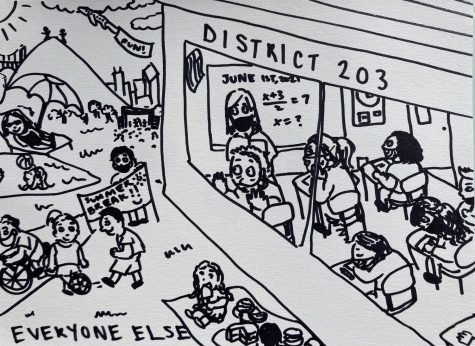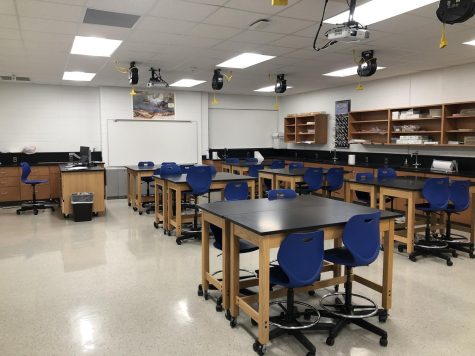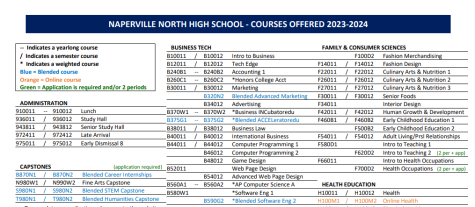Staff diversity a work in progress in 203
Photo by District 203 Website
District 203 officials say the district is making progress on a plan to diversify staff members, but they admit it may take many years before the staff becomes a close reflection of their students’ racial makeup.
District recruiters have fanned out to historically black colleges and universities and hispanic-serving institutions, and the district has looked into how to make District 203 a more welcoming environment for diverse staff members. Dr. Rakeda Leaks, the district’s executive director of equity and inclusion, said the effort will benefit both staff and students.
“It helps you build authentic relationships with more people from diverse backgrounds,” Leaks said. “It also helps to reduce or eliminate stereotypes or biases we might have, because now we have real experience with real people who are from a variety of backgrounds.”
After Leaks’ hire in 2018, she identified recruiting and retaining a diverse workforce as one of four equity priority areas for the district and began, in tandem with the Human Resources department, working towards this goal. The specifics are outlined in the 2020 Comprehensive Equity Plan published by the district.
As of October 2020, the teacher demographics in District 203 are 91.6% white, while the student population is only 61% white. The percentage of white teachers is a number that remains high even after what Chief Human Resources Officer Bob Ross described as a “good hiring year.” In terms of new hiring data for this year, the demographics were roughly 80% white, with the new hires having higher percentages of Asian, Black and Latinx certified staff members than the current demographic data.
“We outperformed our current statistics, so that’s a good year,” Ross said. “But as good as those numbers might sound at first, when you look at the big number, one good year isn’t going to move the needle enough. We need a lot of good years.”
Danielle Brown, a Black teacher at Jefferson Junior High School and alumni of Naperville North, has firsthand knowledge of the core issue that the district is working to address.
“When I was [a student] at Jefferson, I had an 8th grade teacher who was my first and only Black teacher. When I got my job at Jefferson in 2010, it was still that same number. I feel like the needle has not moved enough,” Brown said.
As a way to counter this issue, the district sends its own teachers, specifically those of color, to recruitment events for potential candidates. Tony Pak, an Asian teacher at Scott Elementary School, attended pre-COVID events with the district at the University of Illinois at Urbana-Champaign and the University of Illinois at Chicago.
“It’s so unfortunate that the amount of diverse candidates that came to our table was small. There were a lot of Caucasian candidates flooding our table,” Pak said. “I know that we’re working towards this initiative, so it’s unfortunate that that’s the experience that I’ve had.”
Another obstacle is that District 203 is not as well-known or appealing to teachers outside of Illinois as it is to teachers within the state.
“It’s really interesting because at the universities I went to, we had a long line. They even gave us a special section because they knew 203 was going to hold up a big part of the auditorium. I would say that I probably recruited maybe 50 or 60 candidates in 2 hours at the UIC event. That’s the reputation that we have in the state,” Pak said.
Meanwhile, nationally, this perception is not the same. Brown attended an event in Atlanta, Georgia where she had a very different experience.
“We were trying to stand in their pathway to recruit them, which is unusual for District 203. They were accustomed to there being a long line of people,” Brown said.
Brown also noted that a lack of support systems in place for BIPOC teachers could be impacting on the district’s ability to recruit and retain them.
“Coming from the 203 side and thinking that this is a great job, great benefits — candidates of diverse backgrounds don’t necessarily see it the same way. We need to humble ourselves to understand that diverse candidates have diverse needs,” Brown said. “Things like having places to get the things that they need, places to meet, places to gather, places to live comfortably is a really important aspect and in some ways it had a bigger pull than what 203 had to offer in terms of benefits and salary.”
Candidates asked Brown about things that included local affinity groups, local places to worship and places to get their hair done. Although these may initially seem like small factors, the overall environment of Naperville has a strong influence on the district’s ability to recruit diverse staff, and especially to retain them.
Teacher demographics in District 203 also cannot change quickly because new hires every year are only a small fraction of the total teacher population.
“A lot of teachers come and stay here for over 30 years. Our overall workforce is pretty stable, so it takes a number of years to replace employees with these hiring practices,” Ross said.
The district is looking for the best possible candidates, many of whom often have multiple leads with other school districts as well. Especially as more districts start to explicitly prioritize equity, District 203 has to sell itself to diverse candidates.
“We’re interviewing them, certainly, but they’re also interviewing us,” Ross said. “Some of the best candidates may have just come from another job interview and are about to go to another one after.”
Recruitment is just one of the first steps in the hiring process that the district needs to consider carefully.
“We’re trying to make sure we’re not getting in our own way with hiring new employees. That requires us to look at our application and hiring process, looking at things like the questions we ask during the interview process. We’re even training interview teams, especially at the high school level, about culturally responsible hiring practices. It’s a multi-pronged effort,” Leaks said.
Despite the obstacles, it remains important to many students and staff members that District 203 actively hires a diverse staff.
“The kids benefit from good academics, but what they don’t benefit from is if everyone is the same. When you go out into the real world and you see all types of personalities, work ethics and ways of doing things, it can be a rude awakening,” Brown said.
There is a strong emphasis on diverse staff from a student perspective as well. Jordan King, a junior at Naperville North and the president of the school’s Black Student Leadership Association, sees a need for the work that District 203 is doing.
“It would be a huge benefit to see that representation. A lot of kids of color, including myself, feel like they don’t really have an advocate and they can feel like they’re the only one in a sense. It’s important that students of color have a resource and an advocate that they relate to,” King said.
Although the change in the demographic data is slow, District 203 is hopeful that significant changes will occur as it continues working towards diversifying its staff.
“I think with sustained efforts, we can continue to take positive steps forward,” Ross said.

Reyah is a senior at North and is excited to take on the role of Editor-in-Chief in her third year writing for The North Star. This year, she hopes to...
















